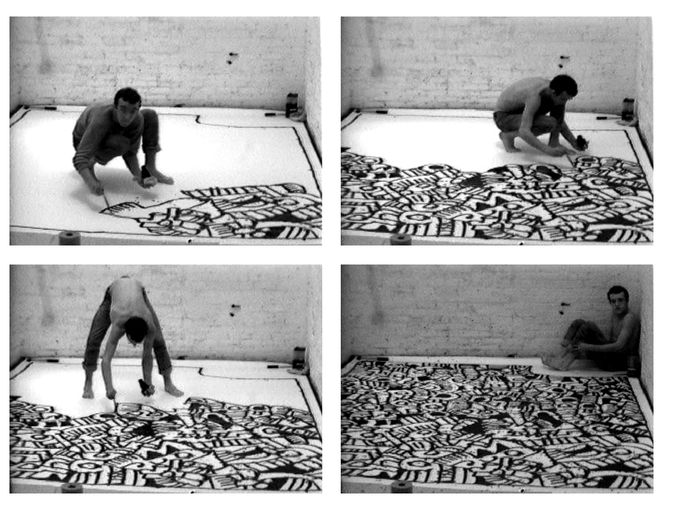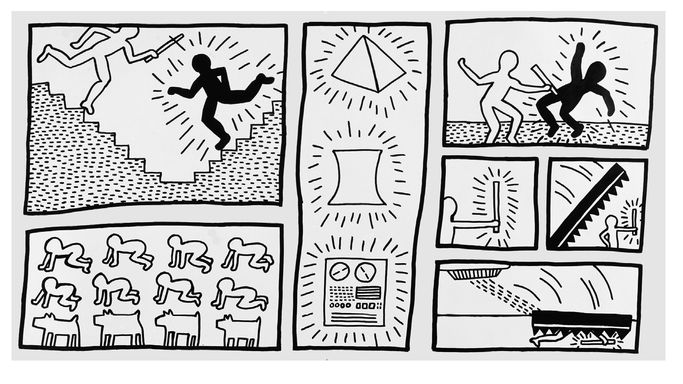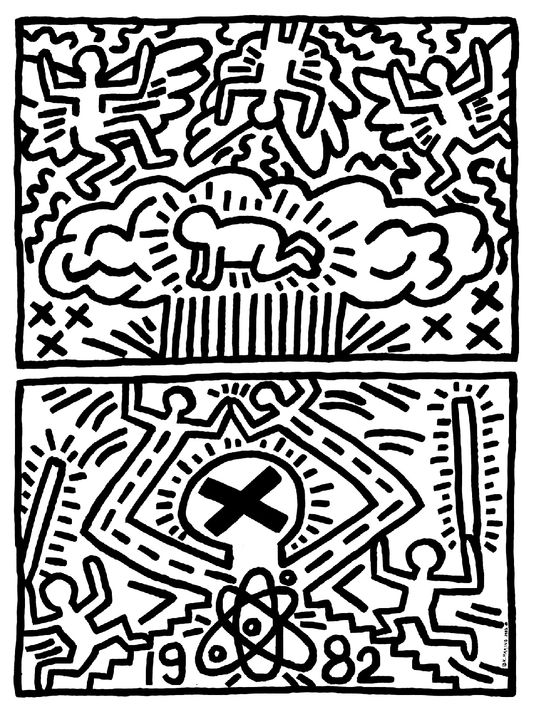Keith Haring Journals (8 page)
Read Keith Haring Journals Online
Authors: Keith Haring

Art is life. Life is art. The importance of both is over-exaggerated as well as misunderstood.
The destructive element exists in all art, but ultimately is determined only by the ideas of the viewer.
Art has no meaning because it has many meanings, infinite meanings. Art is different for every individual, and is definable
only
by the given individual.
only
by the given individual.
There are no set answers, only questions.
When I go to SoHo, I come away with so many visions of new ideas for my own work that I wonder if that’s why I go.
I start to look at the gallery spaces as spaces for my art instead of looking at the art being shown.
There is a lot of shit being shown in spaces that deserve more than shit.
I realized today that one of the main reasons I am here is because it is one of the only cities in the world that has gallery space big enough for my anticipated works.
I saw so many spaces today that look like they were made for my art.
But my art makes itself fit the space, any given space. It defines the space and experiences the space. It changes space and can be part of any given space.
I saw today walls that I could hang paper panels on and make a 30 × 400 foot painting.
It’s wonderful. But how do you get there?
Today I imagined a gallery full of equally spaced video monitors (spaced as painting would be exhibited) all playing different tapes of my video paintings. I want to do it, but I am up against myself. I am up against the fact that I will have new ideas, different attitudes, different feelings and possibly never carry out this vision because another one will appear that seems more important. This gallery, however, existed today in my mind. I was at the opening and it was a nice show.
After the completion of my first video piece—me painting myself into a corner—I am becoming much more aware of movement. The importance of movement is intensified when a painting becomes a performance. The performance (the act of painting) becomes as important as the resulting painting.
Movement as painting. Painting as movement.
Moving toward a work of art that encompasses music, performance, movement, concept, craft and a reality record of the event in the form of a painting.
Almost a kind of diagram of the previous experience (i.e., blueprint, choreography).
Painting as performance.
Video—a medium capable of reaching higher levels of communication—more direct, more involved than painting/ sculpture.
It’s not necessarily true that New York is an impersonal city. In fact, I think it is quite friendly if you let it be. I have had a really nice walk home, exchanged smiles and even a few words. People are open to other people on a certain level, but there is still a barrier of fright (apprehension) on other levels. It can be a wonderful place. I say that now from first-hand experience.
It’s strange, I curse my painting class 24 hours a day except when I’m in class, and then it seems like it might be valuable to my education in some way. But when I leave, I start cursing again.

I’m enjoying the theory and principles discussed in my painting class. I can see how repetition and a controlled vocabulary (symbol vocabulary) could be helpful in the sense that it is a discipline you experience and then later use as a reference point, but for some reason the canvas and oil paint repulse me. I hate them more the more I use them. I love the rich colors of the paint, but the vehicle for the color is so primitive, so restraining. In oil paints, the oil is the vehicle to hold and transport the color. In video, it is light. I guess the use of paint is inevitable. However, if there is a better way I want to know it. Maybe I would enjoy the paint if I could experience it, control it, experiment and play with it. But it is hard to have an experience with oil paint when you are working in pre-drawn areas of shape and painting and re-painting and trying to control it instead of letting it control itself or control you.
Canvas as a material is wonderful. It is sturdy and can be sold and is somewhat permanent. But I am inhibited by it. I pay $8.00 for a 30 × 40 canvas and oil paint, and then I’m paranoid about what it will look like ’cause I spent $12.00 on the painting, and I think it should be worth something. However, when I paint on paper that I have found or purchased cheaply, and use ink that is watered down, I do a whole 4ʹ × 9ʹ painting for next to nothing. I love to paint. And you can see it in the work.
I don’t care if it is a painting/drawing/sculpture performance.
I don’t care if you don’t like it.
I don’t care of the paper is wrinkled, torn.
I don’t care if somebody walked across it and got dirt on it.
I don’t care if the lines vary and there are drips and splatters.
I don’t care if I don’t paint on it.
If I don’t care about all of the lesser elements of the painting; if it is not regarded as “sacred” and “valuable,” then I can paint, without inhibition, and experience the interaction of line and shapes. I can paint spontaneously without worrying if it looks “good” and I can let my movement and my instant reaction/response control the piece, control my energy (if there is any control at all). Maybe control is a bad word.
I can “work” with all these elements and not be worried about the result and whether the finished (nothing is ever really finished) product conveys that whole feeling. It is pleasing to look at. A vacation from order. Or a different kind of order that emerges only from these conditions. It requires individual interaction and individual response—possibly individual interpretation.
It is loose, natural, real, uninhibited, beyond definition. It is temporary and its permanence is unimportant. Its existence is already established. It can be made permanent by a camera. I don’t have to make it permanent.

Chances are, even my raw-paper paintings will last as long as any works in canvas that are being done. Atomic blasts destroy canvas just as fast as paper.
The silicon computer chip has become the new life form. Eventually the only worth of man will be to service and serve the computer. Are we there? In a lot of ways we are. Computer banks control information that we are incapable of dealing with. Are we controlling computers, or are we merely helping them to control us? This is “1984” and it has been for the last ten years. If the computer continues to make the important decisions, store information beyond our mental capabilities, and program physical things (machines), what is the role of the human being?
To service our computer?
And what is the role of an artist?
Should the situation be resisted or accepted?
It appears to me that human beings have reached an end in the evolutionary process. We will, if we continue on the same path, eventually destroy ourselves. We are creating technologies to destroy ourselves. We are self-destructive. Possibly the computer will save us. Maybe it is a good thing that we have created a life form that can continue to evolve and grow beyond our capabilities.
The major question is, though, are we going to be able to control the evolution of the computerized mind, or can it evolve and grow by itself? Will computers be able to decide their future and make it happen without our aid? Computers can do more and more every day. I think we are capable (with our minds, our technologies, our computers) of creating computers as a form of life that can function more efficiently than us in almost every aspect of life.
Machine aesthetic?
Do computers have any sense of aesthetics? Can an aesthetic pattern be programmed and fed into a computer so that it reasons and makes decisions based on a given aesthetic? Why not?
The role of the arts in human existence is going to be tested and tried. It is possibly the most important time for art the world has ever seen. The artist of this time is creating under a constant realization that he is being pursued by the computers. We are threatened. Our existence, our individuality, our creativity, our lives are threatened by this coming machine aesthetic. It is going to be up to us to establish a lasting position of the arts in our daily lives, in human existence.
If humans are expendable, then emotions, enjoyment, indulgence, creative aesthetic, and personality of human beings are expendable.
Question: As an artist aware of this situation, what should my position be?
I agree, to an extent, that if human beings are incapable of evolving further, we should evolve in the form of creating a new life form that can survive the human condition and transcend it. The question that I have trouble with is: Should the new life form be completely oblivious to the aesthetics of human beings? Is it forced, because of its very nature, to be a new life form with no traits of the human being? Have we created a life form “in our own image” or is it a completely different form?

This is the question that the artist of our times has to ask, because it is we who will have to lead the fight against a machine aesthetic or prepare people for it.
Minimal art leans toward the machine aesthetic. It is, in a sense, preparing us for the coming of the machine age—boxes, metal, geometric shapes, sculpture devoid of sculptural aesthetic, ideas devoid of a traditional aesthetic consideration. It influences people’s ideas, and our daily life.
Or there is the possibility that minimal art will have a shocking effect. A warning of the possibilities of the future. Punk rock.
By being negative are you being positive? Is this the approach we should take? Do people see the absurdity, or will they
accept
it as the future, and will it defeat its purpose? Being negative for the sake of trying to reveal the absurdity of the negative act—is that a positive act? Dada—positive or negative?
accept
it as the future, and will it defeat its purpose? Being negative for the sake of trying to reveal the absurdity of the negative act—is that a positive act? Dada—positive or negative?
This is for me the question that will decide my position in the arts. In life . . .
How do you help the human race to realize its predicament? And if you do not see it as a predicament, how do you help to prepare humankind for the reality of a machine-aesthetic world?
Am I a comrade to the computer or to the entire history of humanity? The history of art rests on our shoulders.
Can we abandon it now?
Is it being “abandoned” or is it “evolving,” or “de-evolving”?
Is it our duty, as human beings, to see the importance of an alternative life form? Isn’t the new life form based on all our past discoveries and the result of the entire history of human beings?
Isn’t this a product of the human race, a way to save the human race and continue the evolution of life itself?
Life is not only definable in human terms. It is time that we realize this. We (humans) are a necessary step in an evolutionary process. We cannot know what the end of the evolutionary process is or if there is an end.
For us to stop the evolutionary process of life simply because we are so vain that we believe we are an “end,” and to believe that we can evolve no further, would be disastrous. Life is more valuable than human beings. It is the living force that is within human beings as well as other animals, sky, water, energy, gravity, space. It must be continued at any cost.
Other books
Light Action in the Caribbean by Barry Lopez
Mortal Men (The Lakeland Murders Book 7) by J J Salkeld
Finding Rebecca: A Novel of Love and the Holocaust by Dempsey, Eoin
No Rest for the Wicked by Riley, A. M.
Dan Versus Nature by Don Calame
Looking for Alibrandi by Melina Marchetta
The Panic Room by James Ellison
Storm: Book 2 by Evelyn Rosado
Touch of a Lady by Mia Marlowe
Open World by Casey Moss
